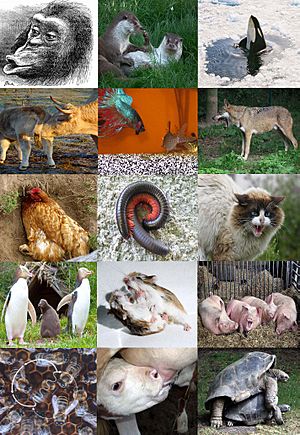Ethology facts for kids
Ethology is the scientific study of animal behaviour. It is a part of zoology, which is the study of animals. Ethology also connects with psychology, which studies human behaviour. Ethologists learn about why animals act the way they do. They study everything from how animals find food to how they raise their young.
Contents
How the Study of Animal Behaviour Began
People have watched animals for a very long time. Even ancient thinkers like Aristotle wrote about animal behaviour. But it became a true science much later.
In 1902, an American ant expert named William Morton Wheeler first used the word 'ethology'. In Europe, the French zoologist Étienne Geoffroy Saint-Hilaire helped start this field. His son, Isidore, wrote about animal behaviour in a way that sounds modern even today. J.-H Fabre (1823–1915), an insect scientist, also wrote popular books about nature. His writings helped keep the study of animal behaviour alive.
Early Discoveries in Ethology
A British biologist named Douglas Spalding (1841–1877) made an important discovery. He was the first to describe something called imprinting. Imprinting is when young animals quickly learn to recognize and follow the first moving object they see. This often happens right after they are born or hatched.
Spalding showed that baby chicks knew how to behave even without practice. Their actions, like following their mother, seemed to be born with them. This showed that some behaviours are instinctive, meaning they are inherited.
In the 20th century, scientists like Charles Otis Whitman, Oskar Heinroth, and Julian Huxley studied bird behaviour. They looked at how birds find mates and build nests. Wolfgang Köhler also studied primates, like apes. His book, Mentality of Apes, was a big step in understanding our closest animal relatives.
Famous Ethologists and the Nobel Prize
In the 1930s, three scientists became very important in ethology. They were Austrian biologists Konrad Lorenz and Karl von Frisch, and Dutch biologist Niko Tinbergen. These three men shared the Nobel Prize in Physiology or Medicine in 1973 for their work.
- Konrad Lorenz lived with the animals he studied. He watched them throughout their lives. He wrote about what he called 'fixed action patterns' (FAPs). These are instinctive behaviours that happen reliably when a certain signal appears. For example, a bird might always do a specific dance when it wants to attract a mate.
- Karl von Frisch studied how honey bees communicate. He discovered their famous 'bee dances'. These dances tell other bees where to find food.
- Niko Tinbergen experimented with what signals trigger fixed action patterns. He found that sometimes an artificial signal could work even better than a natural one. For example, a super-sized fake egg might make a bird try harder to roll it into its nest than a real egg.
Ethology combines studying animals in labs and in their natural homes. It is closely linked to other sciences like ecology (the study of how living things interact with their environment) and evolution. Ethologists often study one type of behaviour, like aggression, across many different kinds of animals.
Tinbergen's Four Key Questions
In the 1960s, Niko Tinbergen created a helpful way to study animal behaviour. He said that to fully understand a behaviour, we need to answer four main questions:
Function: Why Do Animals Behave This Way?
This question asks: How does a behaviour help an animal survive and have offspring? Why does an animal act a certain way instead of another?
The main reason an animal behaves a certain way is that it helps them live and reproduce in their environment. For example, birds fly south in winter to find food and warmth. Mammal mothers care for their young so more of them survive. These actions help the species continue.
Causation: What Triggers the Behaviour?
This question asks: What signals or events cause the behaviour to happen? How has the animal's recent learning changed this behaviour?
For example, what makes a bird sing? It could be the rising sun, the presence of a rival bird, or hormones in its body. These are the immediate causes.
Evolutionary History: How Did the Behaviour Develop Over Time?
This question asks: How does this behaviour compare to similar behaviours in related species? How might it have changed over evolutionary history?
Evolution explains why some animal traits are not perfect. For example, the human eye has a blind spot, but an octopus eye does not. This is because our eyes evolved from earlier forms, and there were limits to how they could change. Over time, our eyes improved by minimizing the blind spot's effect. We usually don't notice it because our other eye fills in the missing information.
Development: How Does Behaviour Change with Age?
This question asks: How does the behaviour change as the animal grows older? What early experiences are needed for the behaviour to appear?
For example, a baby bird might not be able to fly perfectly at first. Its flying skills develop as it grows and practices. Some behaviours also need certain experiences when the animal is young to develop properly.
All behaviours can be understood by looking at these four levels. For instance, why do people eat? The function is to get nutrients for survival. The immediate cause is hunger. Eating and hunger are ancient behaviours found in many species (evolutionary history). And eating habits develop as a person grows (development).
Images for kids
-
Charles Darwin (1809–1882) explored the expression of emotions in animals.
-
Kelp gull chicks peck at a red spot on their mother's beak to get her to give them food.
-
Imprinting in a moose.
See also
 In Spanish: Etología para niños
In Spanish: Etología para niños






